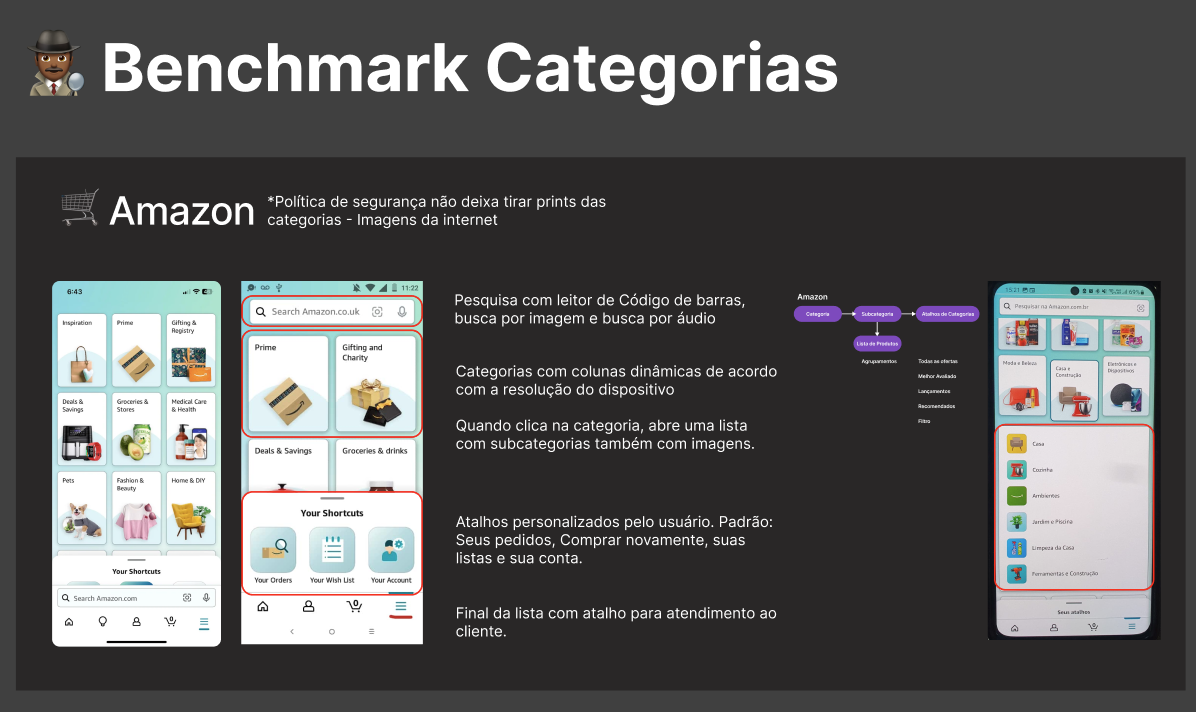After recognizing an opportunity for improvement compared to the current market standard, the Design team at Bemol App embarked on a mission to redesign the departmental structure within the e-commerce platform. Collaborating closely with stakeholders, the team successfully obtained approval for the redesign of this pivotal app feature. This initiative was driven by the understanding that enhancing the user experience in navigating departmental categories is essential for optimizing customer engagement and satisfaction.

Humanizing the experience and making users feel like they are exploring the aisles of a physical store, discovering new things along the way, was the central goal behind the departmental redesign. We aimed to create an online shopping journey that not only streamlined the search for products but also provided a sense of discovery and familiarity, mirroring the tangible experience of navigating through the corridors of a brick-and-mortar store.
Customers should navigate through a data-driven interface as if they had a salesperson by their side.
Customers should spend the least amount of time possible to find what they need.
The distribution of subcategories should make sense to the customer.
How can we convert more sales through department optimization?
What could make an attractive shelf in the department menu?
As part of our process for discovering and redesigning a feature, we conducted benchmarking of both Brazilian and international e-commerce platforms. Benchmarking involves evaluating and comparing the performance, features, and user experience of similar products or services in the market. This step is crucial as it provides valuable insights into industry best practices, emerging trends, and areas for improvement.
By analyzing a diverse range of e-commerce platforms, both domestic and international, we gained a comprehensive understanding of what works well and where there are opportunities for enhancement. This informed our decision-making process and guided the redesign of the feature to ensure it meets the needs and expectations of our users.

We utilized the CSD matrix (Certainty, Assumptions, and Doubts) to ensure alignment between the design team, stakeholders, and technical limitations regarding the direction of the redesign. This collaborative approach involved conducting separate CSD matrices with both the design team and stakeholders. By doing so, we were able to clarify areas of certainty, address assumptions, and highlight any doubts or uncertainties.
The CSD matrix sessions served as a platform for open communication and shared understanding, enabling all parties to voice their perspectives and concerns. This process facilitated consensus on the redesign's direction and allowed for the identification of technical constraints that needed to be considered.
Ultimately, the CSD matrices provided valuable insights that guided decision- making throughout the redesign process, ensuring that the final outcome not only met stakeholders' expectations but also addressed technical limitations effectively.

We employed the UX Cam data analysis tool to examine which categories are most accessed, enhancing our understanding of user behavior within the app. This allowed us to pinpoint popular categories and identify potential areas for improvement.
Analyzing data is paramount in both the redesign and discovery phases. It provides invaluable insights into user preferences, interactions, and pain points. By leveraging tools like UX Cam, we gain a deeper understanding of how users navigate the app, which informs our design decisions and ensures that the redesign aligns with user expectations.

We conducted several rounds of design critique with designers from different departments within the company as part of our collaborative design process. Design critique is a common practice in the design world where professionals review and discuss each other's work to provide constructive feedback and identify areas for improvement.
These design critique sessions provide a valuable opportunity to receive external insights and fresh perspectives on work in progress. By sharing our projects with colleagues from diverse areas, we can gain a broader view and identify potential issues that may have gone unnoticed.
The feedback received during the design critique rounds helped us refine and enhance our ideas, ensuring that the final outcome met the highest standards of quality and usability.

After refining our designs based on the feedback from design critiques, we proceeded to conduct usability testing with both customers and employees in our physical store. Usability testing involves observing participants as they interact with prototypes or mockups of our design to evaluate how intuitive and efficient it is in meeting their needs.
During the usability testing sessions, participants were asked to perform various tasks related to the redesigned features. Their interactions, feedback, and observations were carefully recorded and analyzed. This process allowed us to validate our design hypotheses and identify any usability issues or areas for improvement.
The results of the usability testing provided concrete evidence that our design changes were effective in addressing user needs and preferences. Participants were able to navigate the redesigned features with ease and expressed satisfaction with the improvements made.
Based on the positive outcomes of the usability testing, we confidently moved forward with the production of the redesigned features, knowing that they had been thoroughly validated by real users in real-world scenarios. This approach ensured that the final product would not only meet but exceed user expectations, ultimately leading to a more successful and user-friendly experience for our customers.


In summary, our category redesign project represents the culmination of thorough research, collaborative design, and rigorous testing. Through data- driven insights and iterative refinement, we've crafted a solution that addresses user needs and sets a new standard for engagement. With the redesign validated through testing, we're poised to implement the improvements, confident they will enhance user experience and drive business success. I’m grateful for the teamwork that made this achievement possible and he redesign will soon be implemented in the app.